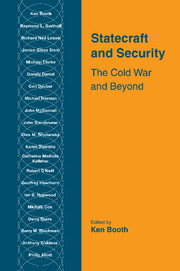Book contents
- Frontmatter
- Contents
- List of contributors
- Preface
- Introduction
- Part one Cold War: lessons and legacies
- Part two Post-Cold War: powers and policies
- 5 Can the United States lead the world?
- 6 Can Russia escape its past?
- 7 Imperialism, dependency and autocolonialism in the Eurasian space
- 8 Western Europe: challenges of the post-Cold War era
- 9 Europe and the wider world: the security challenge
- 10 A new Japan? A new history?
- 11 New China: new Cold War?
- 12 Africa: crisis and challenge
- 13 Of medium powers and middling roles
- Part three Beyond: resistances and reinventions
- Conclusion: security within global transformation?
- Index
6 - Can Russia escape its past?
Published online by Cambridge University Press: 06 October 2009
- Frontmatter
- Contents
- List of contributors
- Preface
- Introduction
- Part one Cold War: lessons and legacies
- Part two Post-Cold War: powers and policies
- 5 Can the United States lead the world?
- 6 Can Russia escape its past?
- 7 Imperialism, dependency and autocolonialism in the Eurasian space
- 8 Western Europe: challenges of the post-Cold War era
- 9 Europe and the wider world: the security challenge
- 10 A new Japan? A new history?
- 11 New China: new Cold War?
- 12 Africa: crisis and challenge
- 13 Of medium powers and middling roles
- Part three Beyond: resistances and reinventions
- Conclusion: security within global transformation?
- Index
Summary
Geography and history
In contrast with the maritime powers of the West, Russia before Peter the Great was essentially a land-locked state. Access to the Baltic Sea was blocked by Sweden and to the Black Sea by the Ottoman empire. Hence, the Muscovite urge to expand had to be directed eastward. After the defeat of the Mongols in the fifteenth century, Russia's Drang nach Osten resulted in the annexation of the vast Siberian landmass, taking Russian settlers to the shores of the Pacific Ocean. In the process, Russia established a contiguous land empire which, in its communist incarnation, outlasted its Western counterparts.
The advent of Peter the Great (1696–1725) marked the dawn of a new era in Russian history. Not content with Moscow's preoccupation with Asia, Peter was determined to Westernise his country by transforming Russian society and by removing the physical obstacles – Sweden and the Ottoman empire – which had barred Russia's access to the maritime routes to the West. In defeating Sweden, Peter opened the Baltic Sea to Russian commerce. The job of establishing Russia as a Black Sea power was completed by Catherine the Great (1763–96).
Expansion to the east and the south continued during the nineteenth century with the result that, by the time the communists gained power in 1917, the Russian empire covered a vast area, stretching from Eastern Europe and the Transcaucasus to Central Asia and the Far East.
- Type
- Chapter
- Information
- Statecraft and SecurityThe Cold War and Beyond, pp. 149 - 163Publisher: Cambridge University PressPrint publication year: 1998



